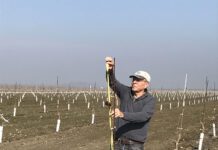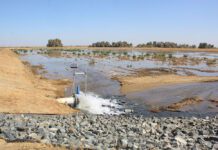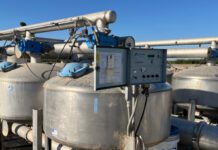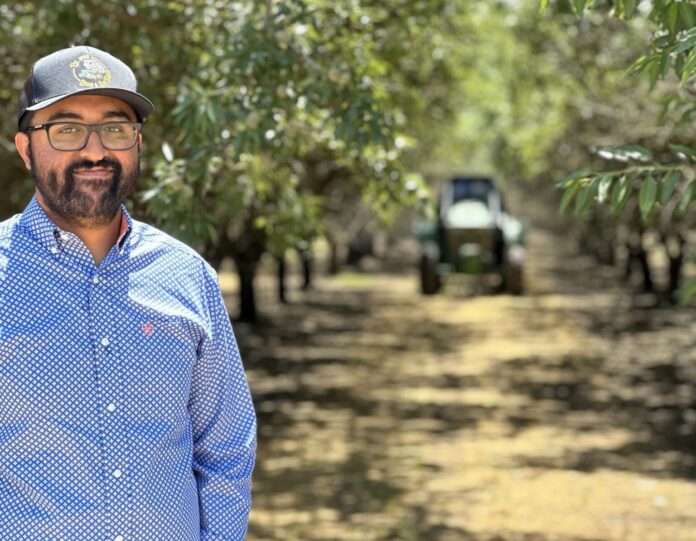
At 22, Gurajan Brar could be considered a rarity in the tree nut farming world. Two years ago, he joined his family’s almond, pistachio and winegrape operation, Brar and Son Farms, after completing an ag business degree at Fresno State.
Unlike so many young people who are choosing to leave family farms behind, Brar is excited about the future of tree nut farming in the state. His youth and enthusiasm are focused on the business side of his family’s farming business. His eyes light up when he talks about finding efficiencies and creating systems that will allow his family’s operation to expand.
He’s also a big proponent of young people in the industry finding mentors to help them learn. In his case, his dad and grandpa have served that role.
“I had to ask my grandpa a bunch of questions,” he said. “I still have to ask my dad a lot of questions on a lot of things.”
Brar shared his perspective and his hopes for the future in an interview with West Coast Nut.
Q. Tell us a little about the history of your farming operation.
My grandparents came here in 1973 from Punjab India. They first settled in Yuba City, and they worked as farm laborers. Then it wasn’t until 1993 when my dad and grandfather bought their first piece of farm ground in Madera. So that’s where we still run our main farming operation. From there, my dad’s grown that operation to now farming winegrapes, almonds and pistachios.
Q. How did you end up in the family business?
When I was growing up, I would work on the farm with my grandfather. Some of my first memories are of turning on the irrigation for our grapes, opening all the valves and spending time with my grandfather.
Originally, I didn’t really want anything to do with farming. I was more interested in the finance side somewhere in the Bay area. But then I decided to stick around because of what my grandparents struggled for, and my dad, too. It took them so long to get to this point, I decided I wanted to continue to build on their legacy and continue to grow the farming operation. I went to Fresno State and got a degree in ag business. During that time, I was hands-on with all day-to-day activities on the farm. Now, I’m in a position where I don’t have to be driving all the tractors; rather, I play a more operational role, making sure everything’s getting done on time and within budget. Also working along with my dad on financial decisions, whether it’s buying new farm equipment or trying new techniques to farm more efficiently.
Q. How would you say that farming practices have evolved over the course of your life?
Back in the day, there would be no moisture sensors. We would rely on what you can see visually, whereas now you have a lot more technology, for example, moisture probes. You can see exactly how much the trees are intaking.
We used to do a lot of flood irrigation. Now, we’ve essentially completely switched over to just drip irrigation, so we focus exactly on what water we’re going to put on. This is a more efficient way of irrigation as well as fertilization, especially with current prices. Other things, too, we’re taking more tissue samples. We’re taking a more technical approach to it. We’ve also added more automation to our pumps to save on certain costs to get away from the peak runtime hours.
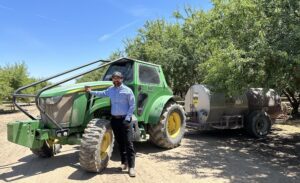
Q. As a young person coming into an existing operation, what kinds of things are you excited about?
Our operation used to be not as technical in terms of actually having complete reports and such. What I’m excited for is our transition to be as efficient as possible and continuing to look for ways to reduce costs. Our main goal now is optimization, optimizing our current portfolio to where we can integrate more tasks in-house. That’s what I’m excited for.
Q. What are three things that keep you up at night about growing nuts?
I’m lucky because I have my dad with me still, so he helps handle the stress. He has to take some of the more heavy burdens of financial, but at the end of the day, it’s still mainly pricing, making sure that we’re profitable. It’s the biggest concern.
Second, with SGMA being implemented, we have ground in the white area. So do we continue to find ways to continue to keep farming those acres without having to reduce water being pumped or to fallow some of the acres.
Lastly, it comes down to the current supply. There are still large amounts of almonds and pistachios being planted and getting into production, adding onto the oversupply, so that’s also a continued concern.
Q. Talk a little bit about the difference between the almond and pistachio markets.
I think one of the major differences is pistachios still has room to grow whereas with almonds seems capped. We’re hitting 3 billion pounds. It’s an intense supply. It’s just about trying to continue to market them.
But on the growing side, there’s a large difference. Pistachios are relatively easier since the window of farming is a bit shorter. You’re farming them intensely for seven months of the year, whereas almonds there’s more stuff happening throughout the year that you have to address.
Q. Do you feel like there’s anything the almond side could learn from the way pistachios are being marketed?
The Almond Board does a really good job all around. The main marketing point is just trying to get people to understand almonds are good for your health and the environment. Almonds have received a lot of bad publicity. We’re just trying to stay ahead and continue to educate people on what exactly we are doing and why, showcasing our more efficient practices.
We are growing three crops on the tree: the hull, the nut and the shell. All of that will get used. I think that’s the main marketing push, just trying to get rid of the stigma that almonds waste water and that they are not good for the environment. I think that’s the main point that we still have to work on.
Q. What’s the thing you’re most hopeful about for the future when it comes to growing tree nuts?
A lot of orchards will eventually get pulled out and replaced, so we’re hopeful the price of nuts will go up, but more so that there’ll be more efficient practices that allow us to cut back our input costs.
Also, in the future, there may be new, higher-producing varieties. I am also hopeful for advancements in technology like automation; this will be big eventually. You’ll have automated tractors that can save labor costs and be more efficient.
Q. In your opinion, what needs to happen to put the industry on the right track?
I think it’s just going to come down to being able to market the nuts and finding more efficient ways to produce them.
We need more secondary markets opening up to different countries. They have tried it all at this point, but at the end of the day, what we are going to need is to see orchards coming out of production that will stabilize the current supply, and then as well, going forward.
Q. What do you think are the biggest assets of the tree nut industry in California?
I think it’s just going back to how many people are actually employed, not just on the farms but also all the equipment, all the different companies that work in the sector. It makes up a big percentage of the overall ag industry.
Q. What would you say is your biggest achievement so far?
I am young, so I am in my early years in farming, helping make our farming operation more efficient and increasing production while continuing to find ways to reduce input costs. Financial tracking of all costs is very important, especially during these hard times due to depressed nut prices. With high costs of farm equipment, it’s very important to keep the tractors serviced and maintained. Parts and labor have gotten very expensive. So, if you have kept everything in good condition, our equipment can run for a longer period of time.
Q. As you talk about cutting input costs, have you explored regenerative farming?
Yes, I have researched cover cropping. This fall, we will be planting cover crops in our pistachio and almond orchards. There are great benefits in cover crops from improving water infiltration to having a habitat for beneficial insects, thus reducing mite pressure during the season.
Q. Talk about how your operation is approaching sustainability.
Just going back to being sustainable with certain practices, like using moisture probes to schedule irrigation sets. Also run our deep wells on off-peak hours. Last year, with all the rain we had, there was just an excess amount of water, so we used programs like on-farm recharge, where you can flood the fields to help bring up the water table. It’s just a way to be more sustainable.
Q. How do you implement practices like orchard recycling?
We’ve transitioned to now where all of our orchards we’ve removed, we do orchard recycling. We just got done with one last year, and we did another block the year before, so we’ve had some experience with it. The wood chips help build organic matter back into the soil.
I think it’s a pretty great thing where you can recycle the trees and put the energy back into the field, incorporate it, get a little bit more nitrogen from the wood chips. The trees are ground and made into wood chips and then spread evenly across the orchard and incorporated back into the soil through discing or plowing.
Q. Talk a little bit about the water situation in California and how that affects you.
With SGMA being implemented, water will play a key part in areas where you will be able to farm. Water is on every [grower’s] mind these days. The threat of thousands of acres needing to be fallowed is keeping a cloud on farming for the future. But I feel [growers] will figure it out, whether it’s on-farm water recharge or rotating to other crops to maybe converting to solar farms. But also, discovering new techniques for reducing water usage. An example may be developing new root stocks that require less water to grow the crop.
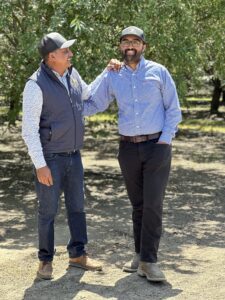
Q. How do you go about giving back to the community?
We continue to help by donating to some good causes, whether it’s with health care (i.e., cancer research) to public education to volunteering in our local community.
One of my long-term goals is to open my own animal shelter. That’s my favorite because I love animals. I want to help every animal.
Q. You’re pretty young yourself, but if you were mentoring a high schooler, what kind of advice would you give to them about getting into farming?
I think one of the biggest things is you need to take a hands-on approach in the beginning, like actually going to a farm, figure out how everything’s done, because without that, you’re not going to have an understanding of all the challenges and rewards that come from farming.
Another thing is just trying to find a mentor who’s already doing it. That way you can ask a lot of questions to help figure out if this is a career path for you. I think it’s just finding that person you can connect with who will help you with answering your questions that can guide you in the right direction.
But it’s really important to actually go get hands-on experience from someone who’s already in the industry rather than just trying to look at it through reading about it. It’s a lot different from reading about it to actually going out into the orchard figuring out how things are done.
Q. Talking about mentors, who was the biggest influence on your learning?
It was probably my grandfather. Even though he didn’t really have a formal education, it was just him giving me those hands-on lessons. And then my dad. He taught me the technical and financial reasons behind why we make certain decisions.
Q. What do you think has been the biggest advancement in growing?
The emphasis on efficiency. Everyone’s been more efficient. You’re not really seeing a lot of growers wasting anything, especially water. Also, reduction in pesticide and insecticide use. For example, we installed mating disruption puffers to help with [navel orangeworm] pressure in some of our blocks.
I think across the board now, growers are more focused on farming more efficiently.
Q. Do you see a lot of growers moving toward things like autonomous tractors?
Right now, it’s mainly large farming operations, then you have some kind of outliers, more growers who if they’re farming, they’ll use it so they don’t have to do it themselves. But you don’t really see that many mid-sized growers doing it.
It’s mainly large ones, but it’s kind of like everything. Eventually the cost will start coming down, so everyone can start implementing it into their operations. Right now, it’s still very expensive.







